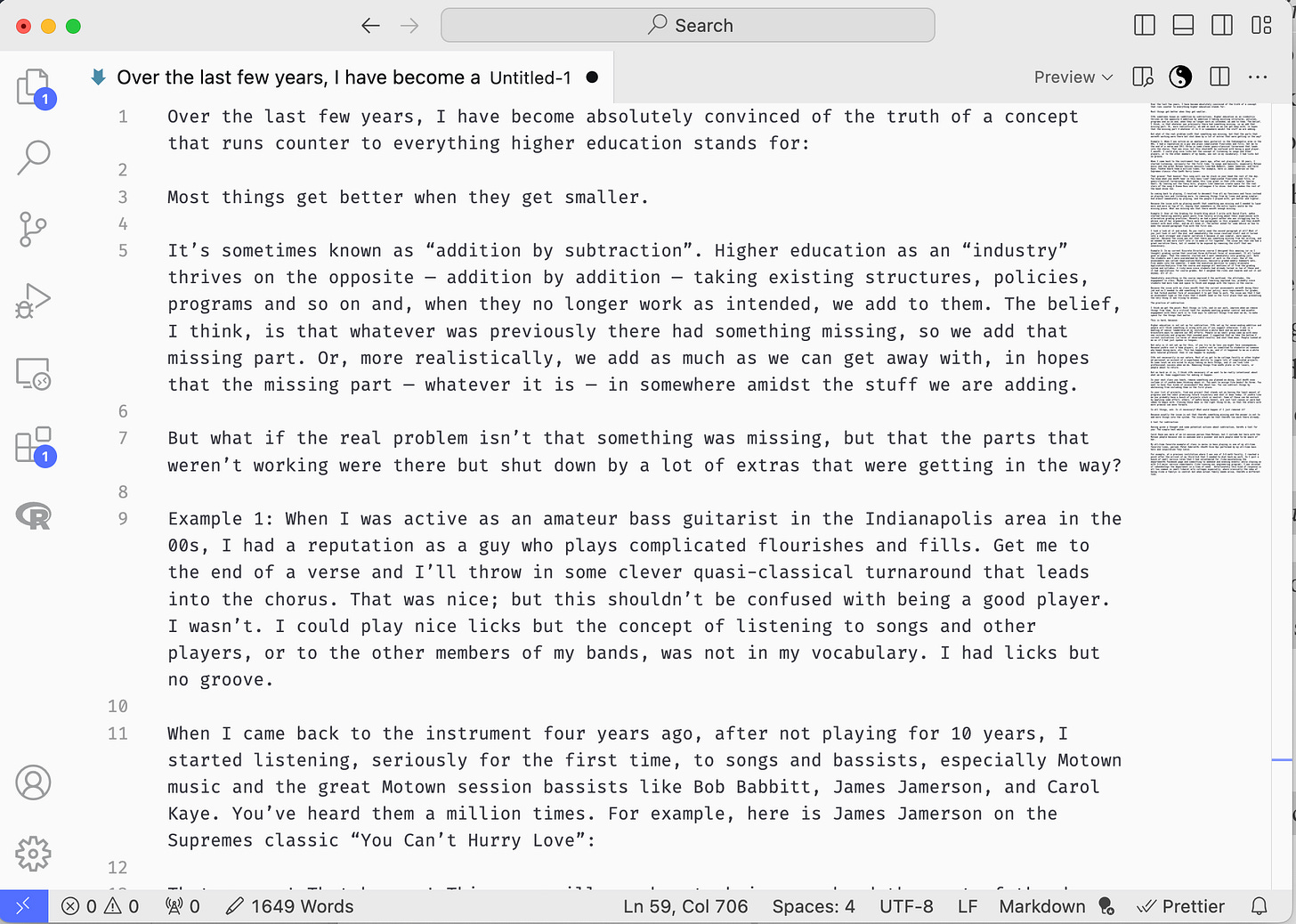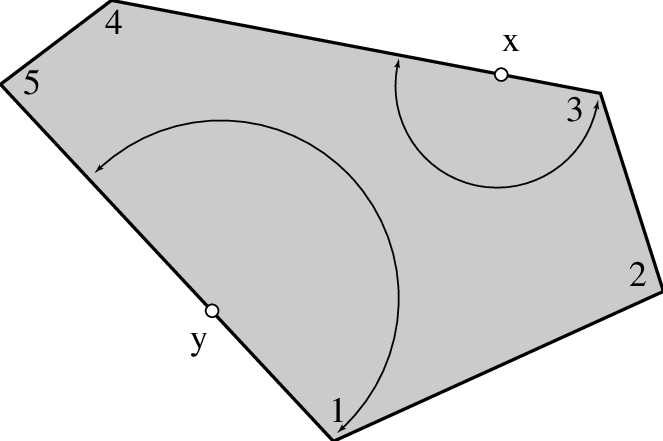The way of subtraction

This is a repost from Intentional Academia, my Substack about balance and purpose in academic work. I post there 1-2 times a month. Stay tuned to the end here for some updated additional thoughts.
Over the last few years, I have become absolutely convinced of the truth of a concept that runs counter to everything higher education stands for:
Most things get better when they get smaller.
It’s sometimes known as “addition by subtraction”. Higher education as an “industry” thrives on the opposite — addition by addition — taking existing structures, policies, programs and so on and, when they no longer work as intended, we add to them. The belief, I think, is that whatever was previously there had something missing, so we add that missing part. Or, more realistically, we add as much as we can get away with, in hopes that the missing part — whatever it is — in somewhere amidst the stuff we are adding.
But what if the real problem isn’t that something was missing, but that the parts that weren’t working were there but shut down by a lot of extras that were getting in the way?
Example 1: When I was active as an amateur bass guitarist in Indianapolis in the 00s, I had a reputation as a guy who plays complicated flourishes and fills. Get me to the end of a verse and I’ll throw in some clever, attention-grabbing quasi-classical turnaround that leads into the chorus. That was nice; but this shouldn’t be confused with being a good player. I wasn’t. I could play nice licks but the concept of listening to songs and other players, or to the other members of my bands, was not in my vocabulary. I had licks but no groove.
When I came back to the instrument four years ago, after not playing for 10 years, I started listening, seriously for the first time, to songs and bassists, especially Motown music and the great Motown session bassists like Bob Babbitt, James Jamerson, and Carol Kaye1. You’ve heard them a million times. For example, here is James Jamerson on the Supremes classic “You Can’t Hurry Love”:
That groove! That bounce! This song will now be stuck in your head the rest of the day. You know what you don’t hear in this bass line? Complicated flourishes and fills, or quasi-classical turnarounds. What makes this line great is that it’s simple. Sparse2. Small. By leaving out the fancy bits, players like Jamerson create space for the real stars of the song — Diana Ross and her colleagues — to shine. And that makes the rest of the band shine too.
So coming back to playing, I resolved to decommit from all my fanciness and focus instead on playing less and listening more, to removing things from my lines and going simpler. And almost immediately my playing, and the people I played with, got better and tighter, and more people were getting up and dancing to it.
The issue with my playing wasn’t that something was missing and I needed to layer more and more on top of it, hoping that somewhere in the extra layers would be the missing piece. What was missing, was that there wasn’t enough missing.
Example 2: Over at the Grading for Growth blog which I write with David Clark, we’ve started featuring monthly guest posts from faculty writing about their experiences with alternative grading practices. Recently we had a guest author who was struggling how to phrase one of her arguments. There were two paragraphs in this argument, and they didn’t connect with each other. The author asked for some advice on how to make the second paragraph flow with the first one.
I took a look at it and asked, Do you really need the second paragraph at all? What if you just took it out? She did, and instantly the issue resolved itself and it turned into a much stronger and clearer narrative — because it was simpler, more sparse, smaller. The issue was not that there was something missing from her writing, and we needed to add more stuff into it to make it fit together. The issue was that she had a great narrative there, but it needed to be exposed by removing the stuff that was unnecessary.
Example 3: In my current Discrete Structures course, I designed this amazing (or so I thought) grading system that involved three different forms of assessment. It all looked good on paper. Then the semester started and I went immediately into grading jail. Both the students and I were overwhelmed by the amount of work in the class. One of the assessments was called “Application/Analysis”, basically graded weekly homework sets. Five weeks into the semester, I made the executive decision to simply eliminate Application/Analysis from the course and expunge all mentions of it from the grading system and syllabus. A risky move, since students had already turned in two of these and it had implications for course grades. But I weighed the risks and rewards and cut it out anyway, all of it.
Immediately everything in the course improved — the workload, the attitudes, the engagement in class. Maybe ironically, student learning improved too, probably since students had more time and space to think and engage with the topics in the course.
The issue with my class wasn’t that the current assessments weren’t doing their job and so I needed to add something — a stricter policy, more requirements for grades, or God forbid another form of assessment — to get them to work. The issue was that I had an assessment type in the class that I didn’t need in the first place that was preventing the very thing it was trying to assess.
The practice of subtraction
I think we get the point: Most things in life, and in our work, improve when we remove things from them. So a critical task for anybody wanting greater control and mindful engagement with their work is to find ways to subtract things from what we do, to make space for the things that matter.
This is hard, because:
- Higher education is not set up for subtraction. It’s set up for never-ending addition and people will think something is wrong with you if you suggest otherwise. I was in a meeting of senior leadership at my institution a while back and we were asked to brainstorm ways to improve our DEI efforts. People in my small group came up with many new initiatives and programs that sounded good. I suggested that we take the bottom 3 current initiatives (in terms of observable results) and shut them down. People looked at me as if I had just spoken in tongues. Maybe I had.
- Not only is higher ed not set up for this, if you try to do less as a higher ed person you might face consequences. Because you’re “not a team player”, or you’re “not as committed to students” as someone who keeps doing more, etc. This has happened to me3, and if it happened to me as a white male tenured professor then it can happen to anybody. There are risks involved.
- It’s not necessarily in our nature. Most of us got to be college faculty or other higher ed personnel on account of a superhuman ability to juggle lots of complicated projects. On some level we are wired to enjoy taking on more things, and it can look like professional success when we do. Removing things from one’s plate is for losers, or people about to retire.
But as hard as it is, I think it’s necessary if we want to be really intentional about what we do. Some suggestions for making it happen:
- In your next class you teach, remove something you planned on doing. Just don’t even include it if you’ve been thinking about it. You want to assign five books? Do three. You want to have four kinds of assessment? How about two. You can subtract things by abstaining from including them in the first place.
- In your list of projects, find one project that stands out as having the least amount of progress and the least promising future trajectory and shut it down today. If you’re like me you probably have a bunch of projects stuck in neutral. Some of those can be unstuck by applying some effort; others, if we’re being honest, are just lost causes or were bad ideas to begin with. Closing those down is the right thing to do, so that the others with more promise can move forward.
- In all things, ask: Is it necessary? What would happen if I just removed it?
Because usually the issue is not that there’s something missing and the answer is not to add more things into the system. The issue might be that there’s too much there already.
A tool for subtraction
Having given a thought and some potential actions about subtraction, here’s a tool for you: The simple text editor.

I have a love affair with plain text editors. I collect them on my computer like some people collect stamps or American Girl dolls. I love the simplicity of text editors. While some are more complicated than others, at bottom what text editors do is… edit text. That’s it. Unlike Google Docs or MS Word there are no bells or whistles necessarily there to distract you with colors or font choices or AI assistants. When you sit down to write with a text editor, it’s just you, your notes, and the screen.
I do almost all my writing in a text editor, then copy/paste the text somewhere, export it, or (usually) I write in Markdown and save the file. It’s just text, no special invisible format characters, so the file sizes are tiny. And since it’s plain text, it is entirely futureproof — as long as computers exist there will be text files and editors that can open them. If my stuff needs extra formatting that Markdown can’t provide, I can do that later once it’s exported.
The text editor is the ultimate tool for those choosing to remove the cruft from their life and work to focus on what’s important. Because this is exactly what text editors do. They are like the software versions of what we should aspire to become.
My editor of choice is Visual Studio Code which is developed by Microsoft. It is free to download and use and runs on Windows, macOS, and Linux (including the Linux found on Chromebooks) and has a web version. It’s simple out of the box but also has a vibrant ecosystem of extensions that add lots of functionality, especially for coding. For example I use an extension that lets me run R programs from within the editor. There are extensions for straight-up writing as well.
Most computers come with a text editor installed: Windows computers have Notepad, and Macs have TextEdit. There are many, many others — some web-based, some with special niche applications, some optimized for mobile, and some that do certain things better than others. I use Typora for all my math class documents for example because it handles LaTeX better than VS Code (IMO). So you have a text editor probably just a few keystrokes away right now. Why not open it up and see what it’s about?


